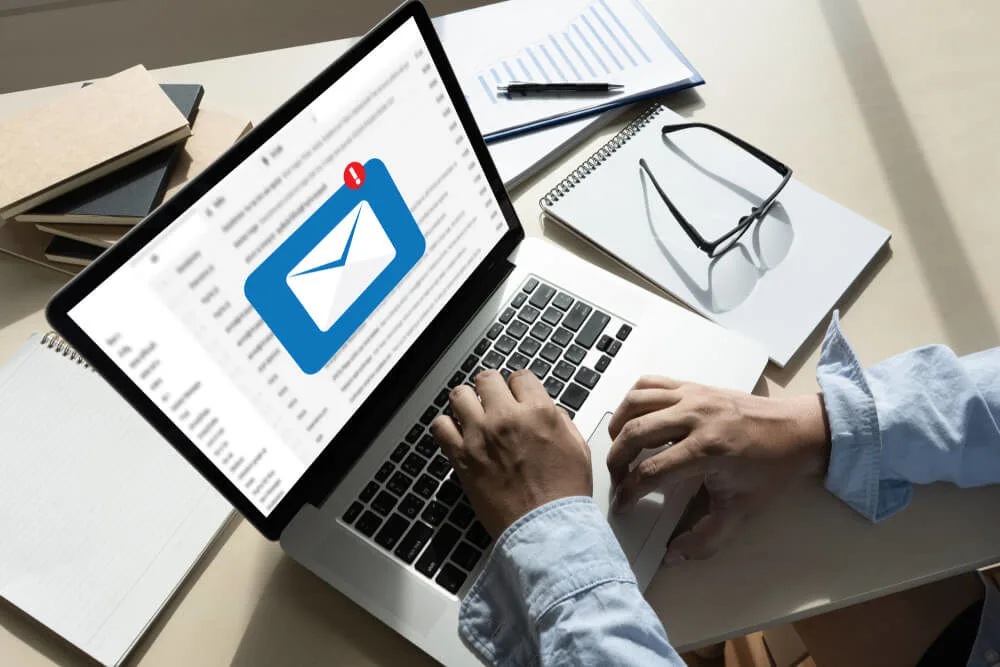Building & Maintaining Your Email List for Marketing
- Email Marketing & Automation

Take a look at your email contact list. Is it bloated with people who never open (or even receive) your emails, or is it clean and only made up of your target customers? Many marketers fall into the trap of stuffing their email list for marketing with as many addresses as possible, but this approach usually falls flat.
In this blog, we’ll review how to build your email list in order to connect with highly-qualified prospects and customers. We’ll cover topics like email list management, email list segmentation, and email list hygiene, among others. Let’s start by reviewing the basic definition of email marketing and the valuable role it can play in your arsenal.
What is Email Marketing?
Email marketing involves sending relevant, highly-targeted emails to a curated list of subscribers. It’s one of the best ways to build and nurture long-term relationships with your prospects and customers. Email marketing can benefit businesses in any industry, as it helps you promote your company, share your story, and / or softly market your products or services.
Because it’s infinitely scalable, email marketing can easily grow alongside your business. It also promotes regular communication and builds trust because you can stay in touch with your customers. And with the advent of email automation, you can stay in regular communication with subscribers without much manual effort. You can use email marketing to:
- Raise awareness about new products or services
- Generate leads
- Build brand awareness
- Sustain customer relationships
- Re-engage lapsed customers
Studies show that 72% of consumers favor email when it comes to communicating with their favorite brands. The best way to capitalize on this is by providing unique, exclusive content via email that keeps subscribers coming back for more.
Ways to Grow Your Email List for Marketing
Wondering how to build an email list? There are a variety of strategic, ethical ways to grow your email contact list. And while building a strong list can require substantial time and effort up front, the long-term benefits include more engaged contacts and higher open rates. Let’s take a closer look at a few ways to grow your subscriber base.
Lead Magnets
Also known as opt-in freebies, lead magnets are complimentary items or services given away to obtain contact information. For example, you might use gated content to give website visitors a reason to join your email list, helping you gather leads. Make sure your opt-in freebie is something your target audience actually wants and will value enough to give you their information. Effective lead magnets include:
- Trial subscriptions / samples
- Exclusive videos
- eBooks
- Whitepapers
- Free consultations

Website Sign-Up Forms & Pop-Ups
One of the simplest ways to grow your email contact list is by including signup forms on your website. In addition to your homepage footer, you should include these forms anywhere you deem appropriate.
A non-intrusive pop-up prompting visitors for their contact information is another great way to build your list. You can use your pop-up in conjunction with the incentive of gated content to convince more people to provide their contact info. Regardless of what you choose, it’s crucial that interested users can easily sign up to receive your emails.
Organic & Paid Social Media
Another effective way to grow your email list for marketing is through organic and paid social media. Offering exposure beyond your immediate followers through things like shares and hashtagging, social media helps you reach more potential subscribers.
Invite followers to join your email list with a clear, succinct message and link to a sign-up landing page. You can also use paid advertising on Facebook, LinkedIn, Twitter, Pinterest, and other social media platforms to reach potential subscribers. Your ads should entice users to visit your website and sign up for your email list for exclusive content.
Discounts & Giveaways
You can also use discounts and giveaways to grow your email list and reach potential customers. Consider offering a discount or free shipping on a user’s first order when they sign up for your mailing list. You can also hold giveaways for new subscribers to win valuable prizes when they join.
Never Buy or Rent Third-Party Email Contact Lists
While you may be tempted to grow your subscriber base by purchasing email addresses, you should never do this. Purchasing or renting mailing lists composed of contact information scraped from other sites is ultimately a waste of your marketing spend.
Purchased email lists are also unethical, since the individuals on them didn’t provide express permission for you to contact them. Plus, some email service providers (like ActiveCampaign) may lock your account if you’re sending to people with no proof of opt-in.
Make sure every email you send includes an unsubscribe link, which is required by federal anti-spam laws. Your subscribers should also have easy access to their email settings so they can opt down (or out) of your emails at any point.
In most cases, emailing people who haven’t provided express permission will lead to you being flagged as spam. And if enough people report you as spam, your brand’s reputation and deliverability will take a hit.
Cultivate Long-Term Relationships with Email List Segmentation
You already know the importance of reaching subscribers at the right time with relevant content they can actually use. This starts with segmentation, which is the process of dividing your subscriber list into smaller groups based on similar characteristics.

Breaking your list down into smaller segments allows you to deliver personalized messaging that shows subscribers you care about their unique needs. Rather than being a nameless face in the crowd, they’ll feel connected and heard. Always remember that despite their similarities, each member of your target audience has a unique personality and set of needs.
Email List Segmentation Categories
When it comes to segmentation strategy and email list management, the sky’s the limit. Consider using buyer personas to inform your segmentation decisions, as these offer a detailed picture of who your target audience is and what they want. Here are just a few ways you can segment your email list:
- Demographic data
- Geographic location
- Past email engagement
- Purchase history
- Hobbies and interests
- Position in the buyer’s journey
- Survey results
- Website behavior
Use Email List Segmentation to Drive Analysis & Strategy
Along with being an effective way to grow your email list for marketing, segmentation can provide valuable opportunities for analysis. Monitoring each email’s open rate, conversions, and click-through-rates can help you determine which messaging is driving the best results. As you learn more about each segment and their preferences, you can send them content that’s even more tailored to their needs.
Benefits of Email List Segmentation
There are many benefits of strategically segmenting your email contact list. For starters, segmented campaigns get 14% more opens and 65% more clicks than mass mailings. Targeted emails sent to specific segments also increase user engagement and can boost eCommerce sales. Plus, segmentation is proven to improve customer satisfaction and retention, leading to increased revenue in the long run.
Implement Thorough & Frequent Email List Hygiene
Building a comprehensive subscriber list of people who actually want to hear from you is only the beginning. Research shows that email lists decline by 20-30% every year, and one-third of your subscribers will never actually open your emails. That’s why diligent email list management and regular data hygiene play such an important role in your success.
While it may seem counterintuitive, scrubbing your email list of unengaged subscribers can actually boost your engagement. This is because it allows you to market to a smaller group of people who truly want to hear from you. Engaged subscribers are the only group of people that matters, since they’re the ones who are purchasing from you. When your subscriber list is bloated with dead weight, you’re leaving money on the table.
Why Subscribers Become Inactive
There are a variety of reasons why your email list subscribers may become inactive. They may not have meant to opt-in in the first place, or they may have joined for a one-time promotion or discount. In other cases, they may no longer have a need for your products or services. And if you’re not following best practices, your emails may even be going directly into their spam folder.
Know When to Scrub Your List
As a general rule, you should clean up your email contact list at least twice a year. You should also immediately scrub your list if you experience any of the following:
- Declining open and click rates
- Open and click-through-rates significantly below industry averages
- High unsubscribe rates
- Increasing spam complaints
- Lackluster overall engagement
Ultimately, a bloated email subscriber list can slow down deliverability rates and make it difficult to determine the effectiveness of your campaigns.
Best Practices for Removing Inactive Subscribers
Before you remove inactive subscribers from your email list for marketing, try running a strategic re-engagement campaign. This is one of the best ways to reconnect with lapsed or one-time customers.

If your emails aren’t being delivered, you should take a closer look at why they’re bouncing. Your email service provider will provide information on whether the bounces are hard or soft, so you should use this to your advantage.
Hard bounces occur when emails can’t be delivered for permanent reasons, such as incorrect addresses or inactive servers. On the other hand, soft bounces happen when emails can’t be delivered for temporary reasons, like full mailboxes or files that are too large.
When the time comes to actually start removing email addresses from your list, be sure to follow these email list hygiene best practices:
- Remove anyone who has specifically requested to be unsubscribed from your list.
- Always consider when a user joined your email list before deciding whether to remove them. You should also factor in the last time they opened one of your emails and how frequently you send to that list.
- Remove any addresses that may have come from a purchased list, since they haven’t provided express permission for you to email them.
- Be sure to create a new segment for inactive subscribers, rather than deleting them entirely. You may want to target these users later with a fresh campaign, so you’ll want to keep their email addresses.
- Remove all duplicate email addresses or duplicate names that have different email addresses.
- Remove any subscribers that appear to have spam email addresses.
- Create an automation for email list cleaning, making it easier to maintain over time.
Benefits of Regular Email List Hygiene
The importance of email list hygiene cannot be overstated, and there are many benefits to keeping your list clean. Let’s take a closer look at the most valuable benefits.
Lower Costs
If you use an email marketing service, you’re probably being charged based on the number of subscribers you have or the number of emails you send. That means every inactive email address is a waste of money. Scrubbing these names from your list is an easy way to improve your ROI while lowering the overall cost of your email marketing.
Improved Statistics
Cleaning up your email list is also proven to offer increased open rates, fewer bounces, and higher click-through-rates. While the same people are opening your emails with a smaller list, that group makes up a higher percentage of total emails sent. Plus, a cleaner list means fewer bounced emails, which improves your engagement data and deliverability.
Reduced Spam Flagging
Most mailbox providers keep a running list of spam complaints. If you keep emailing bad addresses, you’ll start going to everyone’s spam folder, not just people who reported you. A clean list and targeted emails ensure more of your emails arrive in the inboxes of engaged subscribers.
Enhanced Reporting
It can be difficult to determine whether your email marketing efforts are working if your list is full of disengaged subscribers. Trimming the fat leaves you with a list of people who are actually engaging with your brand. You can use the data you glean to improve your future efforts and continue to fine-tune your approach.
If you’re ready to add email marketing services or refresh your existing strategy, we’d love to talk. Our team of experts can help you ethically grow your list while delivering targeted content directly to your customers’ inboxes.
 Danae
Danae